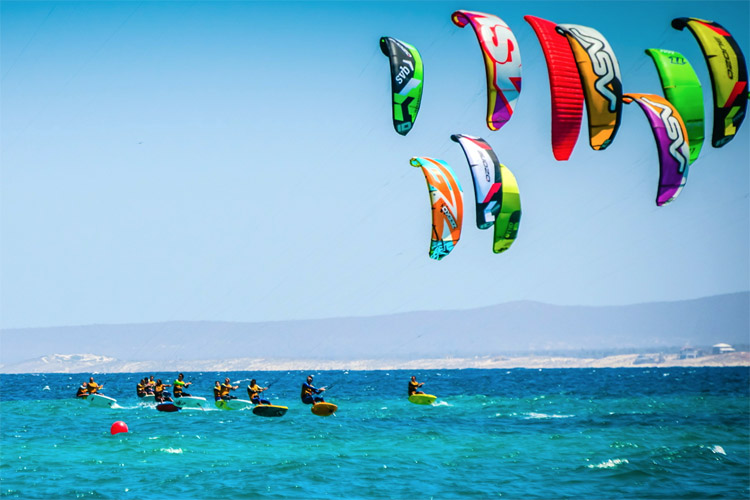Learn the fundamental rules of kiteboarding. Avoid collisions, and stay safe in the water.
Pay attention to the general rules of thumb and respect the priorities.
1. General Common Sense Rules on the Water
Avoid collision at all costs, even when you have the right of way.
Keep clear of less maneuverable watercraft: all recreational watercraft shall keep clear of large commercial ships; more maneuverable motorized watercraft shall keep clear of all sailing watercraft.
When an inexperienced boater is having a problem controlling the boat properly, the experienced boaters should keep clear of the inexperienced boater even when the experienced boaters have the right of way (a boat with an inexperienced "captain" is considered as a less maneuverable watercraft).
2. Traditional Sailing Rules
Opposite tack rule: A boat on port tack with the wind on the port side shall keep clear of a boat on starboard tack.
Same tack rule: A boat to windward (upwind) shall keep clear of a boat to leeward (downwind).
Overtaking rule: An overtaking boat shall keep clear of the boat being overtaken.
3. Wave Sailing Rules
Opposite tack rule: A wave sailor coming in (surfing the wave in) shall keep clear of a wave sailor heading out (jumping the wave).
Same tack rule (on the wave): All wave sailors shall keep clear of a wave sailor in front of or nearest to the peak of the wave (the breaking part of the wave).
All kitesurfers shall keep clear of all surfers (surfers are less maneuverable than kitesurfers).
4. Minimum Clearing Distance for Most Watercrafts
| Highest Points | Minimum Clearing Distance | Other Requirements | |
|---|---|---|---|
| Surfers | 2.5 m | 7.5 m | Kitesurfers have to keep clear of surfers all the time. |
| Personal Watercrafts | 2 - 3 m | 9 m | PWCs have to keep clear of the kitesurfer all the time. |
| Small-to-Medium Motorized Boats | 5 m | 15 m | Motorized boats have to keep clear of the kitesurfer all the time. |
| Windsurfers and Small Boats | 5 m | 15 m | Traditional and wave sailing rules should be applied. |
| Kitesurfers | 2.5 m (upwind kite is high and downwind kite is low) | 7.5 m | Traditional and wave sailing rules should be applied. Furthermore, the upwind kitesurfer should fly the kite higher than 45 degrees vertically, and the downwind kitesurfer should fly the kite lower than 45 degrees vertically. |
| Large Motorized Boats | 10 - 15 m | 30 - 45 m | Motorized boats have to keep clear of the kitesurfer all the time. If the large motorized boat is in narrow, restricted water for its size, the kitesurfer must keep clear. |
| Medium Sailboats | 10 - 15 m | 30 - 45 m | Traditional sailing rules should be applied. |
| Large Sailboats | Very high | Line length | Traditional sailing rules should be applied. If the large sailboat is in narrow, restricted water for its size, the kitesurfer must keep clear. |
| Commercial Ships | Very high | Line length | Kitesurfer has to keep clear of commercial ships all the time. |
5. Learn the Modern Beaufort Wind Force Scale
The Beaufort Wind Force Scale is very important for amateur kiteboarders but should also be taken into consideration by all experienced sailors.
If you're riding in extreme wind conditions, the probabilities of damaging your sail are very high.
Discover the information given by the Modern Beaufort Wind Force Scale.
